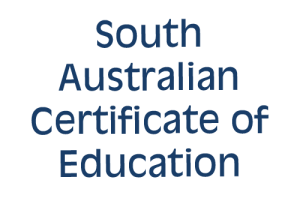SACE

What is the SACE?
Students who successfully complete their senior secondary education are awarded the South Australian Certificate of Education (SACE). The SACE is an internationally recognised qualification that paves the way for young people to move from school to work or further training and study and gain the skills they need for the future as citizens.
The SACE is based on two stages of achievement:
- Stage 1 (normally undertaken in Year 11)
- Stage 2 (normally undertaken in Year 12)
What are SACE subjects?
A full list, brief summaries and full Subject Outlines of SACE subjects are available from the SACE Board website: www.sace.sa.edu.au
How do students gain the SACE?
Students can gain the SACE in the equivalent of two years of full-time study. For most students, this is spread over three years, commencing with Exploring Identities and Futures (EIF) in Year 10.
Stage 1 is completed by most students by the end of Year 11, while most students complete Stage 2 by the end of Year 12. Some students elect to return to school for Year 13 to complete the requirements of the SACE.
Each subject or course that is completed earns credits towards the SACE. Students require a minimum of 200 credits to gain the certificate.
Students receive grades from A+ to E- for each subject. Students need to achieve a C- grade or better for compulsory subjects.
Compulsory subjects requiring C grades include:
- Exploring Identities and Futures - 10 credits at Stage 1
- Literacy – 20 credits (two semesters) from a range of Stage 1 English subjects or courses
- Numeracy – 10 credits (one semester) from a range of Stage 1 Mathematics subjects or courses
- Research Project – 10 credits for an in-depth major investigation at the Stage 2 level
- Other Stage 2 subjects totalling at least 60 credits
The remaining 90 credits may be gained through additional Stage 1 or Stage 2 subjects or SACE Board recognised courses.
What is Exploring Identities and Futures?
Exploring Identities and Futures is a compulsory SACE subject gaining 10 credits and is normally undertaken in Year 10. It is compulsory for students to achieve a C grade or better.
Exploring Identities and Futures helps students to:
- Identify and research career paths and options, including further education, training and work
- Choose appropriate SACE subjects and courses based on plans for future work and study
- Consider subjects and courses available in and beyond school
- Gain an understanding of the SACE Capabilities that underpin all Stage 1 and 2 subjects
- Gain skills for future employment
- Identify their goals and plans for improvement
- Review and adjust plans to achieve their goals.
What is the Research Project?
The Research Project is a compulsory Stage 2 SACE subject gaining 10 credits. It is compulsory for students to achieve a C- grade or better.
Students investigate a topic or question they are interested in, whether it be a scientific study, an art project or even a project in the local community. They develop a question as a focus for their investigation, which they then research using a research framework. Students will commence the Research Project in Semester 2 of Year 11.
What is VET, and how can I do it?
VET is an acronym for Vocational Education and Training that provides students with work skills, particularly in the trades and industry. Students are able to use VET courses to build pathways through the SACE while making significant progress towards completing VET qualifications.
To complete the SACE, students must achieve 200 SACE credits, 180 of which can be gained through VET courses. Depending on the course, students may be able to satisfy the literacy and numeracy requirements of the SACE. The remaining twenty credits are gained from Exploring Identities and Future (10 credits) and the Research Project (10 credits).
The recognition arrangements for VET in the SACE include completed or partially completed qualifications.
Students are able to earn 5 SACE credits for successfully completing 35 hours of VET and 10 SACE Credits for 70 hours. The SACE Board will decide whether the SACE credits earned for a particular VET qualification will be recognised at Stage 1 or Stage 2. Students can refer to the VET Recognition Register for more information.
What is Community Learning?
Students can earn SACE credits for Community Learning in two ways.
- Community Developed Programs
- Self-directed Community Learning
Self-directed Community Learning is gained through informal community activities such as coaching a sports team, being the primary carer of a family member, or leading an environmental project in the community. Students need to provide evidence of their learning for assessment so that the SACE Board can provide recognition and award SACE credits.
TAFE and University entry
TAFE SA recognises the SACE as meeting the entry requirements for most of its courses. It also considers a variety of other qualifications and experiences in its entry and selection processes.
Students who complete the SACE are eligible for University entry, provided they meet certain requirements. For University entry, students need to achieve 80 credits at Stage 2, including three Stage 2 subjects worth 20 credits each. The final Stage 2 credits can be gained in a variety of ways, as defined by the Universities. Universities may also specify required subjects for some of their courses.
Full details of TAFE and University entry requirements are included in the Tertiary Entrance Booklet, which the South Australian Tertiary Admissions Centre publishes.
Visit the SATAC website for more information: www.satac.edu.au
Students with Disabilities
To meet the learning needs of individual students with significant impairment in intellectual functioning and/or adaptive behaviours associated with their disability, the SACE Board makes available a set of modified subjects. Modified subjects are highly individualised subjects in which curriculum and assessment are designed around developing one or more SACE capabilities and personal learning goals that are appropriate for the student.
Eligible students can complete the certification requirements of the SACE using one or more modified subjects at Stage 1 and Stage 2.
For 2024, the following modified SACE subjects will be offered at Mount Barker High School:
- Business Innovation
- Creative Arts
- Cross-Disciplinary Studies
- Design, Technology and Engineering
- English
- Health and Wellbeing
- Languages and Culture
- Mathematics
- Exploring Identities and Futures
- Physical Education
Research Project - Scientific Methods
- Society and Culture
For further information, please contact Nicki Hacquoil, Senior Leader Inclusion, at the school.
SACE Planner and Checker
The SACE Planner and Checker is an online tool that allows students and teachers to plan and check enrolments towards the SACE.
A paper version of the SACE Board course planner can be downloaded from the SACE Board website.
Further information
Visit the SACE Board website www.sace.sa.edu.au

